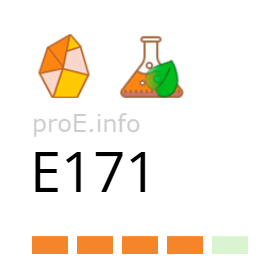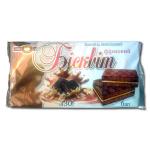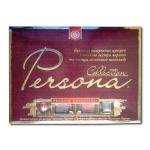
Other names for the additive (synonyms)
General Information
The additive E171 (titanium dioxide) is a white powder that gives products a stable, bright white color. In the food industry, it is used as a colorant.
Titanium dioxide (TiO2) was first discovered and described as a natural mineral in 1821, but its industrial use began much later. In 1916, the first factories for the production of pigment-grade titanium dioxide opened in the USA and Norway. It quickly replaced toxic white lead (PbCO₃) and became the main white pigment in the paint and coatings industry.
By the mid-20th century, the substance began to be used in the food industry — initially in confectionery glazes and tablet coatings. In 1966, the U.S. Food and Drug Administration (FDA) officially approved the use of titanium dioxide as a food additive, provided its concentration does not exceed 1% of the product’s weight. In the 1970s, the additive was assigned the number E171 and was recognized as safe in European countries.
However, in 2021, the European Food Safety Authority (EFSA) reviewed the available scientific data and concluded that the potential genotoxicity of TiO2 particles cannot be ruled out. As a result, since 2022, titanium dioxide has been banned for use in food products in the European Union.
In nature, titanium dioxide occurs in mineral forms such as rutile, anatase, and brookite. For industrial purposes, the substance is synthetically produced. There are two main methods of industrial production:
- sulfate process — from ilmenite concentrate using sulfuric acid,
- chloride process — from titanium tetrachloride at high temperature.
In the CIS region, the largest producer of titanium dioxide is Ukraine. Most of the raw material is produced by two enterprises: JSC "Sumykhimprom" and PJSC "Crimean Titan". More than 85% of the output is exported.
Effects on the Body
Benefits of additive E171
Titanium dioxide has no nutritional or biological value. Additive E171 is not inherent to the human body and has no beneficial effects.
Risks of additive E171
Inhalation of titanium dioxide powder has been associated with carcinogenic effects. A study by the U.S. National Toxicology Program (NTP, 2011) showed that rats developed malignant lung tumors after long-term exposure to TiO₂ dust.
The International Agency for Research on Cancer (IARC) classified titanium dioxide as a possible human carcinogen (Group 2B) when inhaled.
In food products, additive E171 is used in a non-dusty form and was long considered safe. However, in 2021, EFSA revised its safety assessment and concluded that the genotoxic risk of E171 could not be ruled out, since TiO₂ nanoparticles may cause DNA damage. Consequently, the additive is no longer considered safe for use in food within the EU.
Meanwhile, the FDA, as the regulatory authority in the United States, notes that some of the genotoxicity tests reviewed by EFSA involved materials that were not food-grade colorants, and some tests used exposure routes irrelevant to human dietary intake. The FDA found no concerns regarding potential genotoxicity based on the available data and stated that TiO2 did not cause cancer in NTP carcinogenicity studies. Therefore, the FDA allows the safe use of TiO2 as a color additive in food.
Other effects observed in animal studies include inflammation, immunotoxicity, possible neurotoxicity, and particle accumulation in tissues with chronic consumption. However, carcinogenicity from oral intake has not been demonstrated.
Uses
Titanium dioxide is used in the food industry as a white coloring and whitening agent under the code E171. It is most commonly found in:
- powdered milk and milk substitutes,
- glazes and confectionery products,
- chewing gum and dragées,
- instant porridges and desserts,
- food supplements and medicines (in tablet coatings).
Outside the food sector, titanium dioxide is widely used in the production of paints and coatings, plastics, paper, cosmetics, and toothpaste.
Legal Status
In Ukraine, additive E171 is officially approved for use in food products.
In the European Union, titanium dioxide has been banned for use in food since 2022, following the EFSA opinion from 2021.
In the United States, titanium dioxide remains approved and is listed as GRAS (Generally Recognized As Safe). Its use is limited to technologically justified amounts. The maximum allowable concentration in food must not exceed 1% by weight.

